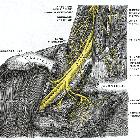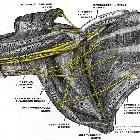Nervus thoracicus longus


The long thoracic nerve is a posterior branch from the C5, C6 and C7 roots of the brachial plexus, and supplies the serratus anterior muscle.
Gross anatomy
Origin
The long thoracic nerve arises from the anterior rami of the fifth, sixth and seventh cervical nerves.
Mnemonic
A useful mnemonic for the cervical roots of the long thoracic nerve is:
C5-6-7 reach to heaven (as abducting the glenohumeral joint causes scapular winging).
Course
The nerve descends posterior to the roots of the brachial plexus and anterior to the scalenus posterior muscle and has a long course along the chest wall in the mid-axillary line to lie on the superficial surface of the serratus anterior muscle, which it innervates.
Variant anatomy
The long thoracic nerve also has supply from the eighth cervical nerve in ~10% of the population.
Related pathology
The long thoracic nerve is susceptible to damage (causing backpack palsy) due to its long and superficial course either from direct trauma or stretching of the nerve. Damage to the nerve may also occur during surgical procedures including thoracoplasty, axillary nodal clearance, mastectomy and resection of the first rib. The risk of injury to the long thoracic nerve is far greater in patients following a radical mastectomy (with clearance of the axillary lymph nodes) compared with simple mastectomy.
Long thoracic nerve palsy causes winging of the scapula as the serratus anterior muscle no longer holds the scapula against the chest wall.
Siehe auch:
und weiter:

 Assoziationen und Differentialdiagnosen zu Nervus thoracicus longus:
Assoziationen und Differentialdiagnosen zu Nervus thoracicus longus:
